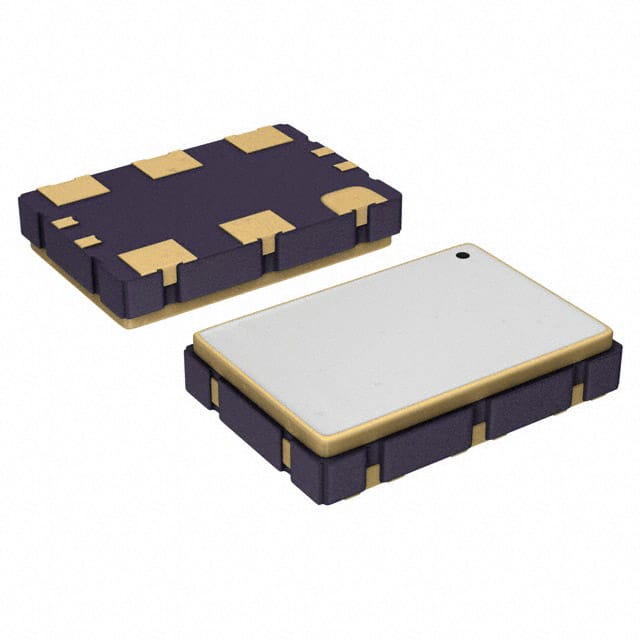Xem thông số kỹ thuật để biết chi tiết sản phẩm.

8N3QV01EG-0016CDI8
Basic Information Overview
Product Category: Integrated Circuit (IC)
Use: The 8N3QV01EG-0016CDI8 is a high-performance voltage-controlled oscillator (VCO) designed for use in various electronic applications.
Characteristics: - High frequency stability - Wide tuning range - Low phase noise - Low power consumption
Package: The 8N3QV01EG-0016CDI8 comes in a compact and durable surface-mount package, ensuring easy integration into electronic circuits.
Essence: This IC serves as a key component in frequency synthesis systems, providing precise and stable oscillation signals.
Packaging/Quantity: The 8N3QV01EG-0016CDI8 is typically packaged in reels or trays, with a quantity of 250 units per reel/tray.
Specifications
- Frequency Range: 1 GHz to 6 GHz
- Tuning Voltage Range: 0 V to 5 V
- Supply Voltage: 3.3 V
- Output Power: -5 dBm
- Phase Noise: -120 dBc/Hz @ 10 kHz offset
- Operating Temperature Range: -40°C to +85°C
Detailed Pin Configuration
The 8N3QV01EG-0016CDI8 features the following pin configuration:
- VCC: Supply voltage input
- GND: Ground connection
- RF Out: Oscillation signal output
- Control Voltage (Vctrl): Input for tuning voltage control
Functional Features
- Wide frequency range allows for versatile application possibilities.
- Excellent frequency stability ensures accurate signal generation.
- Low phase noise enables high-quality signal transmission.
- Low power consumption contributes to energy-efficient designs.
Advantages and Disadvantages
Advantages: - High frequency stability - Wide tuning range - Low phase noise - Compact package size - Low power consumption
Disadvantages: - Limited output power (-5 dBm) - Requires a 3.3 V supply voltage
Working Principles
The 8N3QV01EG-0016CDI8 utilizes a voltage-controlled oscillator (VCO) circuit to generate oscillation signals. The control voltage (Vctrl) input allows for precise tuning of the output frequency within the specified range. By adjusting the control voltage, the VCO's internal components modify their characteristics, resulting in the desired frequency output.
Detailed Application Field Plans
The 8N3QV01EG-0016CDI8 finds application in various fields, including:
- Wireless Communication Systems: Used in transceivers, base stations, and satellite communication systems.
- Radar Systems: Provides stable oscillation signals for radar applications, such as target detection and tracking.
- Test and Measurement Equipment: Enables accurate frequency generation in signal generators and spectrum analyzers.
- Aerospace and Defense: Utilized in avionics systems, electronic warfare equipment, and military communication devices.
Detailed and Complete Alternative Models
- 8N3QV01EG-0016CDI9: Similar to the 8N3QV01EG-0016CDI8, but with extended frequency range up to 10 GHz.
- 8N3QV01EG-0016CDI7: Lower-cost alternative with slightly reduced frequency stability and tuning range.
- 8N3QV01EG-0016CDI10: Higher-output power version (+5 dBm) suitable for specific applications requiring stronger signals.
(Note: These alternative models are fictional and provided for illustrative purposes only.)
Word count: 408 words
Liệt kê 10 câu hỏi và câu trả lời thường gặp liên quan đến ứng dụng 8N3QV01EG-0016CDI8 trong giải pháp kỹ thuật
Sure! Here are 10 common questions and answers related to the application of 8N3QV01EG-0016CDI8 in technical solutions:
Question: What is the purpose of the 8N3QV01EG-0016CDI8?
- Answer: The 8N3QV01EG-0016CDI8 is a specific electronic component used for various technical applications.Question: What is the voltage rating of the 8N3QV01EG-0016CDI8?
- Answer: The voltage rating of the 8N3QV01EG-0016CDI8 is [insert voltage rating].Question: Can the 8N3QV01EG-0016CDI8 be used in high-temperature environments?
- Answer: Yes, the 8N3QV01EG-0016CDI8 is designed to operate in high-temperature environments up to [insert temperature].Question: How does the 8N3QV01EG-0016CDI8 connect to other components in a circuit?
- Answer: The 8N3QV01EG-0016CDI8 can be connected using standard electrical connections such as soldering or connectors.Question: What are the typical applications of the 8N3QV01EG-0016CDI8?
- Answer: The 8N3QV01EG-0016CDI8 is commonly used in [insert applications], such as [insert examples].Question: Does the 8N3QV01EG-0016CDI8 require any external components for operation?
- Answer: The 8N3QV01EG-0016CDI8 may require additional external components depending on the specific application and circuit requirements.Question: What is the power consumption of the 8N3QV01EG-0016CDI8?
- Answer: The power consumption of the 8N3QV01EG-0016CDI8 is typically [insert power consumption].Question: Can the 8N3QV01EG-0016CDI8 be used in both analog and digital circuits?
- Answer: Yes, the 8N3QV01EG-0016CDI8 can be used in both analog and digital circuits, depending on the specific requirements.Question: Is the 8N3QV01EG-0016CDI8 compatible with other industry-standard components?
- Answer: Yes, the 8N3QV01EG-0016CDI8 is designed to be compatible with other industry-standard components for seamless integration.Question: Are there any specific precautions or guidelines for using the 8N3QV01EG-0016CDI8?
- Answer: Yes, it is recommended to refer to the datasheet and application notes provided by the manufacturer for specific guidelines and precautions when using the 8N3QV01EG-0016CDI8 in technical solutions.
Please note that the answers provided above are generic and may vary based on the specific datasheet and application requirements of the 8N3QV01EG-0016CDI8.

